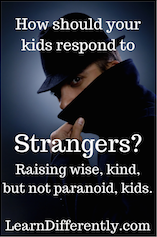Strangers: how should your child respond?

By Kathy Kuhl
A scary video on Facebook launched a good conversation, for once. It showed an experiment repeated with several children. A stranger with puppy approached a child at a playground, chatted, let the child pet the puppy, and invited the child “to come see the other puppies.” In each case, the parents had given permission to the experimenter beforehand, and confidently predicted the child would not go. But every time, the child took the stranger’s hand, and walked away.
Call it the irresistible power of puppies, but it was alarming.

Then a friend objected. The video’s message seemed to be “Don’t be a bad parent, watch your kids every second.” Yet we know being helicopter parents doesn’t equip our children for life. So how do we keep our kids safe?
First, understand that usually abductors are not strangers. In 2000, the U.S. Office of Juvenile Justice and Delinquency Programs reported that more than three-fourths of kidnappings were committed by family members or acquaintances of the child.
So we need to do more than just discuss “strangers.” We need to teach safety generally.
We also need to be consistent. We say, “Don’t talk to strangers,” but we talk to strangers all the time: the store clerk, the deliveryman, and so on. Sometimes, we tell our kids to answer when these adults speak to them. So what exactly do we want our kids to do? Do they know? Kids with learning challenges may be very bright, but need these rules spelled out and rehearsed more than other children do.
Third, from a Judeo-Christian heritage, kindness to strangers and foreigners is a duty. Lisbeth, a veteran homeschooler, wrote:
How do we as Christians help our children be wise and careful, while still training them to be kind to strangers ~ thereby sometimes entertaining angels unawares? I thought one of the great blessings of homeschooling was that I didn’t have to have the conversation about “not talking to strangers” until my children were much older because I was always with them! I didn’t want to add to their fears unnecessarily… It was a great gift to me that I had the freedom to accompany to them to Gymboree, gymnastics, tennis lessons, piano lessons, etc., so that I was observing their interactions with others and making sure that the adults who were teaching/coaching them were always appropriate. I feel as though [it was a] gift which is often overlooked when we talk about home schooling.
We want to raise kind and savvy kids. So we need to talk about strangers. We can talk in terms of circles of closeness, and what’s appropriate with each level. For instance, strangers shouldn’t kiss you, but your Grandma may, even if you haven’t seen her in three years.
For those of us with kids who have trouble with being touched, we may well need to explain to Grandma ahead of time and negotiate. We can spell out the social expectations and role-play with our kids before we gather with relatives.
Our children also need to know who to go with and when. Our family learned one tip on an FBI tour: we chose a password that only we and our children knew. I told the kids that if I needed someone else to pick them up in an emergency, I would give that adult the password, and it would be safe to go with them. Once we used it, I changed the password.
Another stranger you want your child to go with is a firefighter in mask and full gear, rescuing your kid if there is a fire. My brother-in-law, a volunteer firefighter, offered to take us to the station and model his gear. Most fire stations have open houses so your child can see this.
We should also discuss and practice what do to if an adult is trying to kidnap a child. Don’t just tell your child to yell. People will only think your screaming child is upset, especially if the abductor pretends to be a weary parent. Yelling “I don’t know you!” or “You’re not my parent!” is far better.
Our children also need to understand what is appropriate and inappropriate touching, what to do about it, and how to tell adults. These are delicate but important issues. The best information I’ve seen on how to have these conversations is “The Importance of Teaching Body Safety” an article on the Parenting Special Needs magazine’s website. The author, Jayneen Sanders, whose pen name is Jay Dale, explains, “Just as we teach road safety with a clear, child-friendly and age-appropriate message, the teaching of body safety uses a similar sensitive and age-appropriate technique.”
Among other good points, she says that kids need to know which are their private parts and what those parts are called. She explains that on average, an abused child has to report to three people before he or she is believed. So we must teach our kids to keep talking about it to trusted adults.
What are your strategies to help your children be safe? Answer in the comments below, please.

